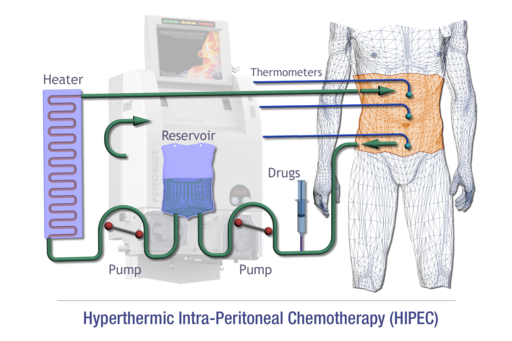What is HIPEC?
HIPEC stands for hyperthermic intraperitoneal chemotherapy. “Intraperitoneal” means that the treatment is placed inside the abdominal cavity. “Hyperthermic chemotherapy” means that the chemotherapy is heated to a temperature greater than normal body temperature. It is a procedure used to treat mesothelioma where heated and concentrated chemotherapy is placed directly in the surgical cavity during surgery.
Paul Kraus was diagnosed in 1997 before HIPEC was widely available. Although Paul has survived more than 20 years with peritoneal mesothelioma, he did not have HIPEC. In his book, he explains other healing methods used by mesothelioma patients who may use HIPEC.
Dramatic Mesothelioma Survival Improvement With HIPEC
Since the introduction of HIPEC, the median survival of peritoneal mesothelioma patients has increased. In fact, the most dramatic improvement in survival has been for patients with the epithelioid subtype. These patients typically live several years after the procedure. Fortunately the epithelioid subtype is the most frequent type of peritoneal mesothelioma diagnosed. Paul Kraus has survived over 20 years without the procedure and in his book he explains other healing modalities that can benefit any mesothelioma patient even those who use HIPEC.
HIPEC is Different Than Other Chemotherapy Treatments
Typical chemotherapy is put into an artery or vein and the drugs are circulated throughout the body. HIPEC is different. With HIPEC, chemotherapy is placed in direct contact where the mesothelioma tumors are removed and cancer cells may remain. Because the chemo isn’t going throughout the body, higher doses of the drugs can be used. In addition, heating the chemotherapy is thought to improve the absorption of the chemo by the mesothelioma cells. The can help kill remaining cancer cells that are left after surgery.
HIPEC and HITOC Can Be Used for Both Peritoneal and Pleural Mesothelioma
HIPEC was originally designed for peritoneal mesothelioma and it has become the standard of care for treating peritoneal mesothelioma in many centers. Some doctors have even begun using it in pleural mesothelioma. In those cases the procedure is called HITHOC for “hyperthermic intrathoracic chemotherapy.”
How HIPEC Works in Mesothelioma
Before patients receive HIPEC treatment, doctors perform surgery to remove the tumors they can see within the abdomen. This procedure is often called “cytoreductive surgery.” Once cytoreductive surgery is completed and as many tumors as possible have been removed, the heated concentrated chemotherapy is introduced into the abdomen to hopefully destroy remaining cancer cells.
The chemotherapy is heated to about 106 degrees Fahrenheit. This is about the water temperature of a very hot Jacuzzi. This temperature is chosen because cancer cells die at about 104 degrees Fahrenheit, while normal cells die at about 111 degrees Fahrenheit.
The heated chemo is left to bathe the surgical cavity for approximately one to two hours. After that amount of time, the chemo solution is drained from the abdomen and the surgical incision is closed. The procedure is then completed.
What to Expect After HIPEC
Cytoreductive surgery with HIPEC can last an average of 8-14 hours, depending on the extent of disease. Patients typically remain in the hospital for 10-12 days after the procedure. It is not uncommon for patients to feel fatigued for 2-3 months after the procedure. Your doctor will tell you how much time you should spend resting and how much time you should be active.
Being active may be prescribed because it can help prevent possible complications of surgery, such as blood clots forming in the legs and pneumonia. Although the healing process may take a long period, setting and accomplishing goals, helps patients participate in their own recovery.
Although Paul Kraus did not have HIPEC, in his book he describes many healing approaches that can help you during your recovery.
HIPEC Advantages
HIPEC provides a number of advantages over standard chemotherapy. These advantages include:
1. Concentrates chemotherapy within the abdomen and decreases the amount of chemotherapy that the rest of the body is exposed to. This reduces chemotherapy side effects.
2. Allows for high doses of chemotherapy and improves the amount of chemo that is absorbed by mesothelioma cells.
Risks of HIPEC
With HIPEC, like any surgery, there is always the possibility of a complication. The most common complications with HIPEC are bleeding and infection, which can occur with any surgery. Other less common complications include blood clots in the legs that can travel to other parts of the body.
Other Cancers
Although HIPEC is typically used for mesothelioma patients, it can also be used to treat other cancers that have spread within the abdomen.
Discover How Paul Survived Mesothelioma
Paul Kraus is the longest living survivor of mesothelioma. Discover how he did it by requesting a free copy of his book today. We will ship it overnight to your door. Click here to get your copy now.
